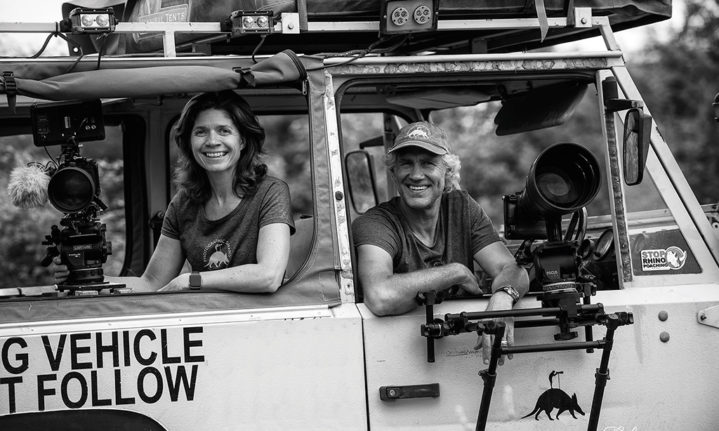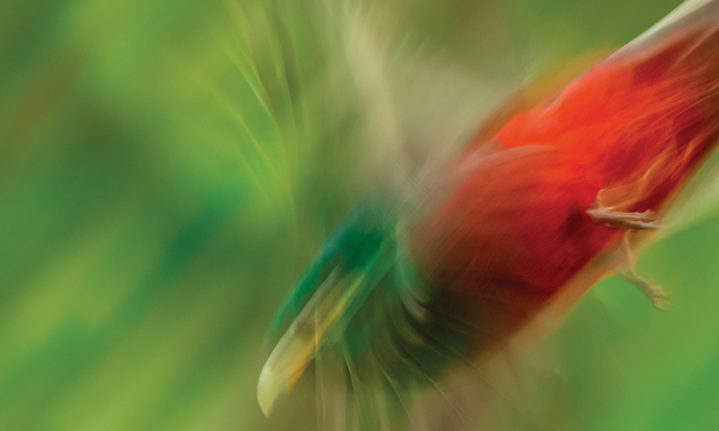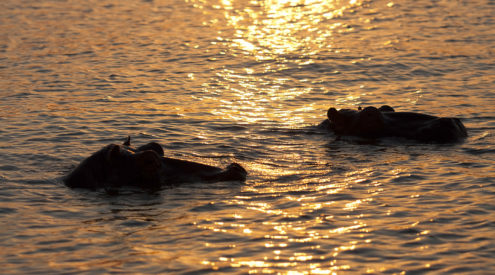If you spot a Narina trogon, consider yourself fortunate as it’s one of Africa’s most elusive birds. But to spend weeks with the species – as Hannes Lochner and Noa Koefler did near the Blyde River Canyon – is a once-in-a-lifetime experience.

‘The sighting of my life was a green and red flash – I wanted to capture a photo exactly l as I ‘d seen it, so I oped for a slow shutter speed.’ – Hannes Lochner
Photography: Hannes Lochner
Nature added an unexpected opportunity for my wife and I. We were working on a new photographic project photographing wildlife by night in a private game reserve near the Blyde River Canyon. One evening, on our way to set up our equipment for the night shoot, we saw a green flash in front of our vehicle – that was my first glimpse of a Narina trogon.
It was Noa’s second sighting. While I was away on safari with guests in the Kalahari last year, she saw one in the same area near the Blyde River. Of course, she sent me a message with a photograph, just to rub it in. Little did we know how remarkable this new encounter with the trogon would be.

Spiders, grasshoppers and this smooth caterpillar were its preferred prey.
We had our camera gear ready in the game-drive vehicle and followed the trogon on foot. Being a film-ographer, it was a bit more challenging for Noa – to set up a tripod and lug other heavy gear – but we did manage to get a few worthwhile shots that evening.
The next morning, despite a long night shoot, we were excited about the prospect of finding the bird. With ‘guns’ loaded, we set off to locate it and, after a few hours, we were thrilled to hear its call, putting us on the trail of this scarce specimen. After finding it again, we were able to spend plenty of time capturing images in good light.
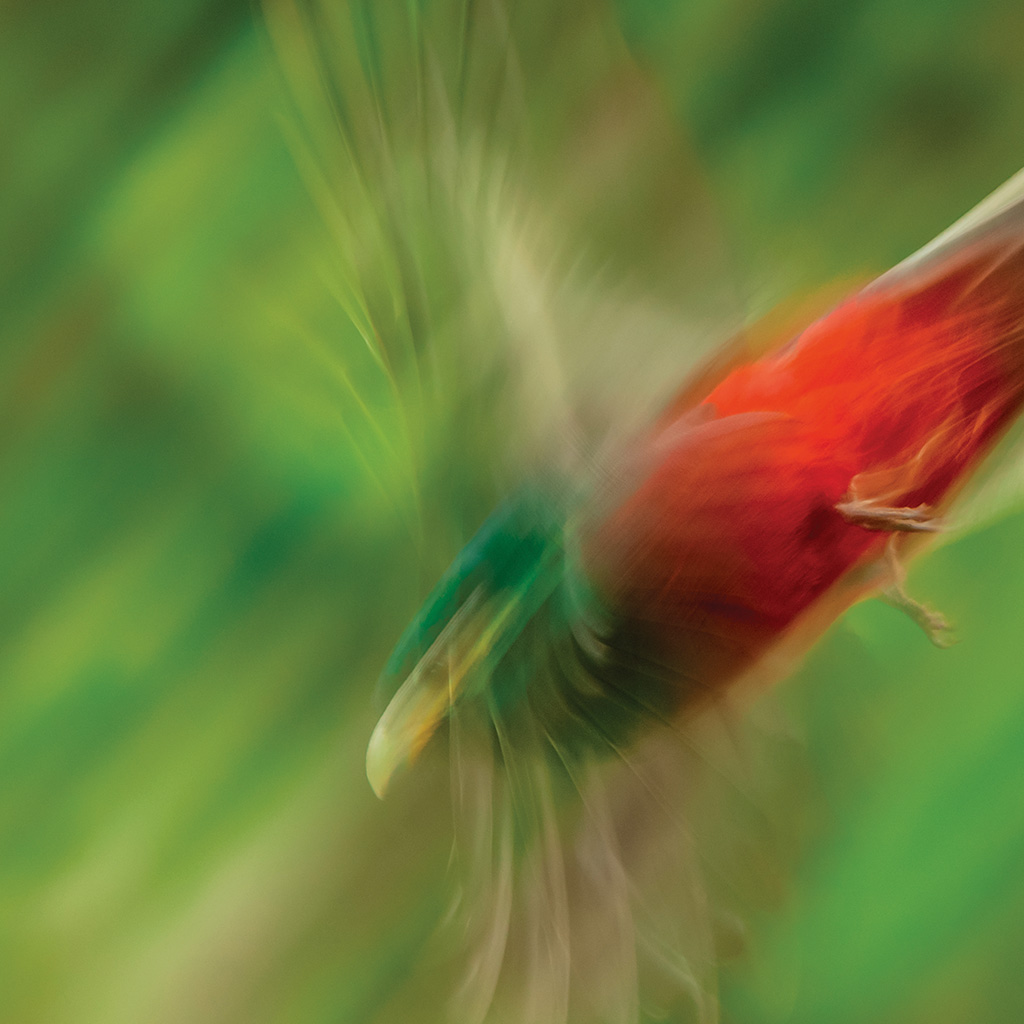
It was tricky capturing this agile flyer in motion with a slow shutter speed.
Over the course of the next few weeks on the night project, photographing the trogon became our ‘day job’ and we managed to get closer and closer. Initially the bird mostly showed us its back, flying off just as we were in a position to take a photograph or produce a film strip. But, as the trogon became familiar with our presence, it slowly opened its world to us.
The bare, blue-green throat patch is expanded when calling and the bird may fluff out the breast feathers in display. It performed like a catwalk model, cleaning itself, calling, performing acrobatics to capture insects and gulping down long, hairy worms. It even perched on our game drive vehicle, as if wanting to join us on a game drive. Every night after spending 8–10 hours following it – and despite photographing other creatures – we could not help thinking of it and its colours and when we did manage to sleep, it filled our dreams.

A time to rest.
Despite the wonder of the bird, our bush-exploring was complicated by a profusion of ants, swarming all over us after the heavy rains in December. They attacked our feet, especially when we were wearing sandals. Their bites were painful, particularly when we slapped them. We learnt to tolerate the pain at first, then it got so bad we covered our feet with plastic bags. The ants didn’t walk over the plastic, strangely enough.
For the rest of our trip, we moved about with bags around our feet, somewhat noisily but by then, fortunately, we were good friends with the trogon. But the real reward was spending so much time out in nature with an elusive creature after the long pandemic lockdown.
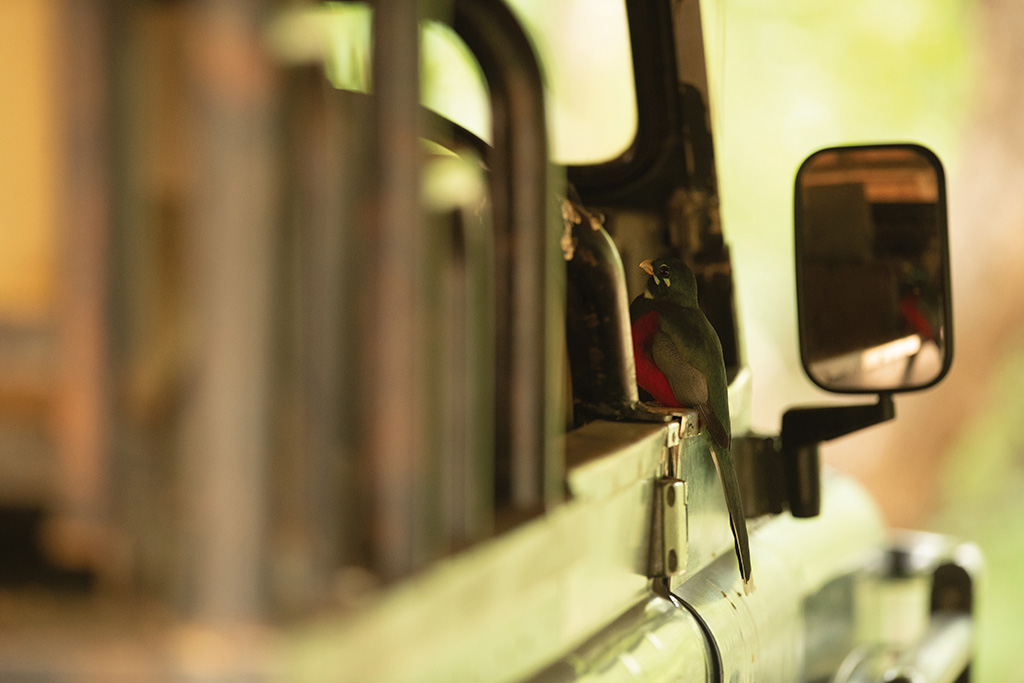
A favourite shady perch – with a bonus mirror to fluff up its feathers for the ladies.
Why is it called a Narina trogon?
François le Vaillant is considered to be Africa’s finest ornithologist. He was born in Suriname in 1753 and was the son of a Frenchman. In 1781 he was transferred by the Dutch East India Company to the Cape where he collected all manner of bird specimens during his travels. During his time at the Cape, he was romantically involved with a mistress by the name
of Narina, believed to be of Khoikhoi origin. He named this beautiful bird after her. We decided our new friend needed another name, thinking that, as a male he might not be happy with
Narina. So he became Jagger, named after the game-drive vehicle, Mick Jagger, his preferred perch.

Husband and wife team Noa Koefler and Hannes Lochner share their passion for wildlife through the lens of their cameras. A native of the Dolomite Mountains in the southern Tyrol, Italy, Noa’s love for wildlife grew after she came to Africa and enrolled in a course in field guiding and wildlife filmmaking. While working on a film project in the Kalahari, she met Hannes, an award-winning photographer and creator of several excellent wildlife photography books on the Kalahari and Okavango. They now work together on diverse photographic projects throughout Southern Africa.
Hannes uses @sonyalpha camera systems and both he and Noa use @cartoni.camerasupports for equipment support and @lacie_tech drives for image and video storage. Follow their adventures on patreon.com/hanneslochner










